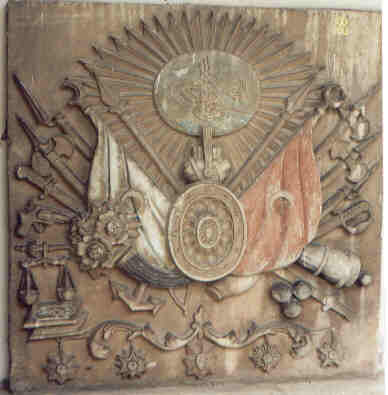


FOTW beschäftigt sich mit der Wissenschaft der Vexillologie (Flaggenkunde).
Alle auf dieser Website dargebotenen Abbildungen dienen ausschließlich der Informationsvermittlung im Sinne der Flaggenkunde.
Wir distanziert uns ausdrücklich von allen hierauf dargestellten Symbolen verfassungsfeindlicher Organisationen.
Last modified: 2013-06-22 by ivan sache
Keywords: topkapi | istanbul | quran | sultan | osman | coat of arms: ottoman | selim i |
Links: FOTW homepage |
search |
disclaimer and copyright |
write us |
mirrors
See also:
Imperial coats of arms in Topkapi Museum - Photos by Dov Gutterman, 31 July 1999
Click on the images to see a larger version
The flags shown on the second coat of arms are with a crescent and star whereas those shown on the first one are with a crescent only.
Dov Gutterman, 31 July 1999
Selim I's standard - Photo by Baris Kilicbay, 20 August 1999
The red sandjak of the Ottoman sultan Selim I (1470-1520) represents the Zulfikar sword. This flag, carried to Egypt by Selim I, can be seen in the Topkapi Museum. During the 16th-17th centuries the Zulfikar flags were widespread in Ottoman army and numerous red Zulfikar flags left in the battles in Europe are shown in museums and one can even see a red, triangular Zulfikar flag in the Doge Palace in Venice.
Baris Kilicbay, 20 August 1999
The following items were shown in an exhibition of the masterpieces of the Topkapi Museum (Istanbul), held in the Palace of Versailles (France), Summer 1999.
This is a small (ca. 15 x 5 x 2 cm) silver box which contained a Quran and was tied to the top of the Army banners, to put God's protection of them. This might be put in parallel with the famous oriflamme, which had the same kind of protective power for the ancient kings of France.
Some of the displayed caftans are ornated with the three discs placed in triangle which appear also on the flag of the Rear Admiral of the Porte in a 19th century Dutch flag chart. The notice of the exhibition says that this emblem represented the snow lion and was strictly reserved to the Sultan. So it might be either a coincidence or a misattribution in the flag chart.
A painting of the 18th century made by a French envoy in Istanbul shows a French royal ship, with the Bourbon ensign in main mast and a plain red flag in jack position.
Ivan Sache, 19 July 1999
In the Czech magazine Vexilologie [vex] #98 there were several articles dealing with the Turkish flags. Some of these flags are on display at Topkapi Museum and many information came from there as well. It seems that one of the oldest flags belonging to that museum was used by Osman himself.
Pier Paolo Lugli, 30 July 1999
I don't think it would be possible to preserve the flag Osman used (13th century), it is probably only an attribution.
Baris Kilicbay, 30 July 1999
Hosted by: Fanshop-Online.de und Handy-Shop.de
Tipp: Apple iPhone XS MAX